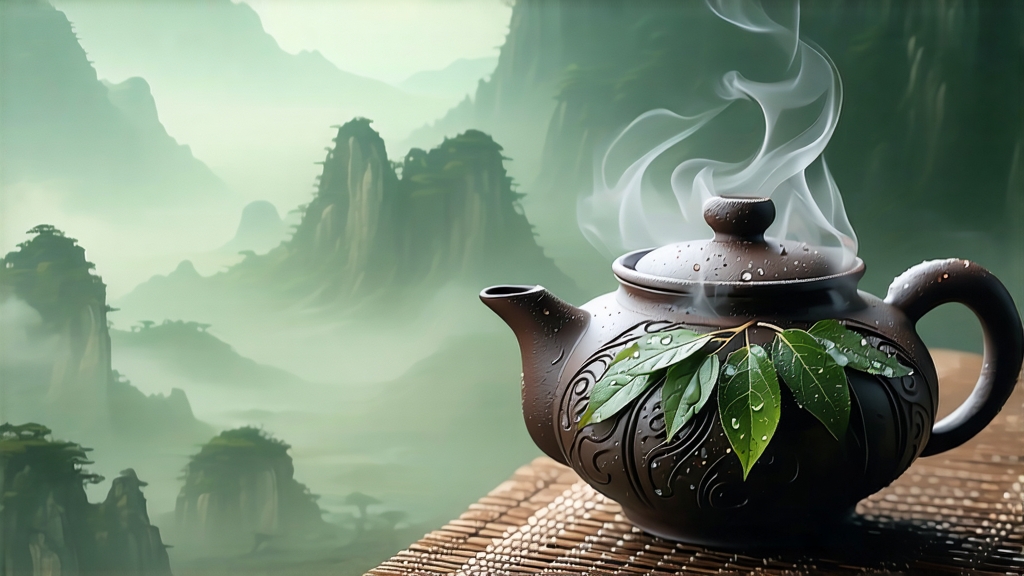
If green tea is China’s springtime and pu-erh its autumn, then Tie Guan Yin is the suspended moment of an early summer dawn—half awake, half dreaming. Among the five major oolong families, none carries more folklore, more aromatic magnetism, or more stylistic diversity than the Iron Goddess of Mercy. Born in the granite heart of Anxi, Fujian, Tie Guan Yin has travelled from mountain monasteries to Michelin-starred tearooms, yet it still insists on being listened to rather than merely consumed. This essay invites the international tea lover to hear its story, from soil to soul.
-
Historical Echoes
The name first appeared in imperial tax registers of 1725, but villagers near Xiping insist the cultivar is older, a gift from the Bodhisattva Guanyin herself. The most quoted legend tells of a pious farmer, Wei Yin, who found a glowing iron statue of the goddess in a crevice of Rangqiao Hill. After praying daily, he discovered a single tea shoot sprouting from a crack in the rock. He cultivated it, named the tea after the iron icon, and shared cuttings with neighbors. Whether myth or marketing, the tale captures the spiritual aura that still clings to every leaf. -
Terroir: Where Granite Breathes
Anxi County is a labyrinth of subtropical valleys whose soils are weathered granite mixed with red laterite. Day-night temperature swings of 10 °C slow the growth of amino acids while encouraging fragrant terpenes. The highest gardens—above 800 m on Xianghua, Gande, and Longjuan ridges—sit in a perpetual cloud veil that refracts sunlight into soft, silver wavelengths. Locals call this “mountain breath,” claiming it tightens the leaf’s cellular walls and concentrates its signature orchid note. -
Cultivar Lineage
True Tie Guan Yin is propagated from a single, genetically distinctive bush known as “Hongxin Wei” (Red-heart Wei). Its leaves are elliptical, thick, and serrated like a miniature saw; the central vein blushes red when back-lit. Over centuries two sports emerged:
• Wuyi Tie Guan Yin—transplanted to northern Fujian’s cliff gardens, it acquires a rock rhyme (yan yun) of mineral bite.
• Pinglin Tie Guan Yin—grown in Taiwan’s Wen Shan district, it leans toward a creamy, gardenia bouquet.
Yet purists still look south to Anxi for the canonical expression. -
Craft: The Rhythm of Oxidation
Modern Anxi masters speak of “three mornings, five handwritings.”
Morning 1 – Picking: Only the standard “half-open” leaf—three leaves and a bud—is plucked between 9 a.m. and noon when dew has evaporated but turgor pressure remains high.
Morning 2 – Wilting: Leaves are sun-withered for 20–40 minutes, depending on cloud cover, then moved onto bamboo trays in climate-controlled rooms.
Morning 3 – Shaking: The most cinematic step. Every hour the master tosses the leaves into the air, letting them slap back onto the tray. Micro-ruptures at the edges invite oxygen, edging oxidation toward 30 %. The pause between tosses is dictated by the leaf’s sigh—when the rim feels velvet-soft, it is time to stop.
Writing 1 – Fixation: A 260 °C wok kill-green arrests oxidation within 90 seconds, locking in the jade-green center.
Writing 2 – Rolling: Cloth-wrapped bundles are twisted underfoot, breaking cell walls without shredding the leaf.
Writing 3 – First Bake: 70 °C for two hours reduces moisture to 20 %.
Writing 4 – Second Bake: 105 °C for ten minutes sets the iconic iron-like lustre.
Writing 5 – Third Bake (optional): Charcoal embers at 60 °C for six hours create the “nong xiang” (roasted aroma) style favored by Chaozhou gongfu aficionados.
- Style Spectrum
• Qing Xiang (Fresh Fragrance): Light oxidation, quick bake. Liquor the color of early spring chardonnay; aroma of white orchid and honeydew; finish like mountain spring water.
• Nong Xiang (Traditional Roast): Double charcoal bake. Liquor amber; nose of toasted almond, baked yam, and incense wood; texture velvety, with a returning coolness in the throat that the Chinese call “sheng